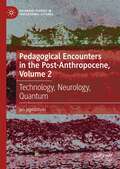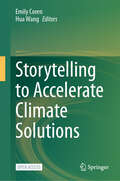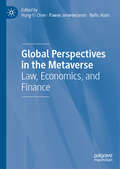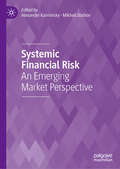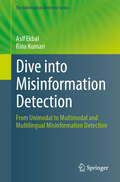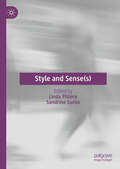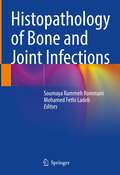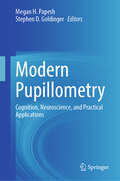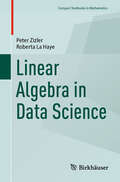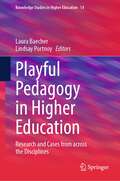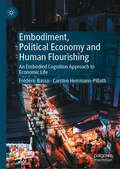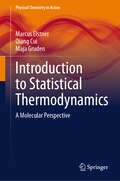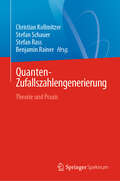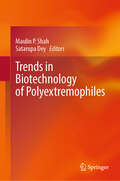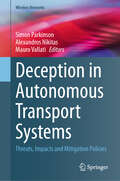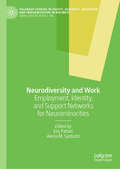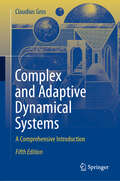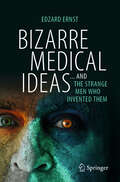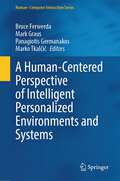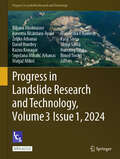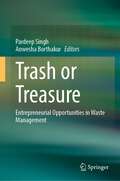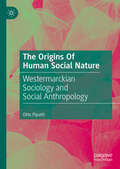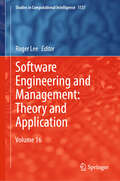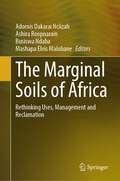- Table View
- List View
Pedagogical Encounters in the Post-Anthropocene, Volume 2: Technology, Neurology, Quantum (Palgrave Studies in Educational Futures)
by jan jagodzinskiAs a follow up to Pedagogical Encounters in the Post-Anthropocene, Volume I, this book addresses three major areas in response to the post-Anthropocene: Technology, Neurology, Quantum. Each of these areas is broadly addressed in relation to the concerns that have arisen both theoretically and educationally. As in Volume I, the author terms these to be encounters as each area presents a particular problematic when addressing the phase change that the planet is undergoing where the anthropogenic labour of global humanity is contributing to climate change, endangering our very existence. Technology in education has been a significant development. There is a concerted effort to review this development placing stress on the rise of learning machines and algorithms. In the second encounter the vast literature on neurology is addressed, especially neurodiversity and the various symptoms that have emerged in the post-Anthropocene era. The last section reviews issues related to quantum theory as this is fundamental to tensions between physics and metaphysics. The volume concludes with the author’s own pedagogical proposal for the future.
Storytelling to Accelerate Climate Solutions
by Hua Wang Emily CorenThe climate is changing faster than our cultural practices are adapting to it. This Open Access volume, co-edited by Emily Coren (a science communicator) and Hua Wang (a communication scientist), presents a survey of the latest in agency-focused climate storytelling. Together, practitioners and scholars across different fields shared their knowledge, experience, and insight about how stories can be designed and told to engage, enable, and empower individuals and communities in climate communication and action. You will learn a wide range of narrative strategies and exemplary applications of climate storytelling in terms of professional practices (e.g., education, literature, journalism, popular media), genres and formats (e.g., drama, comedy, fiction), media platforms (e.g., television, radio, mobile), and communication modalities (e.g., text, visual, audio, multisensory). Entertainment-education has been proven over decades to be an effective tool for social and behavior change in the public health sphere and has not yet been applied at scale to the massive ongoing climate–related disasters that we need to solve now, fast. There is an urgent need to rapidly apply and adapt public engagement tools for climate communication to speed up our response times for climate change mitigation and adaptation. This book takes a snapshot of where climate storytelling is currently at, describes where it fits within a climate communication landscape, and supports the next steps of its development. It facilitates the of creation climate storytelling efficiently by sharing and amplifying what is working well, and building collaborations between practitioners and researchers.This is an open access book.
Global Perspectives in the Metaverse: Law, Economics, and Finance
by Nafis Alam Hung-Yi Chen Pawee JenweeranonThe metaverse is undergoing rapid and transformative changes, yet it has thus far lacked a comprehensive scholarly examination from a global and comparative standpoint. The publication addresses existing gaps by introducing fresh perspectives and frameworks across various domains within the metaverse, including law, economics, and finance. Drawing upon the expertise of an international cohort of scholars and practitioners, this volume illuminates emerging interdisciplinary insights with global relevance, facilitating a comparative analysis of diverse aspects of the metaverse. Timely and essential, this book contributes significantly to the metaverse literature, addressing urgent issues in this evolving landscape.
Systemic Financial Risk: An Emerging Market Perspective
by Alexander Karminsky Mikhail StolbovThis book provides an analysis of various sources and forms of systemic financial risk. It focuses on the most pressing research questions for both advanced and emerging market economies, including green finance, ESG agenda and related risks, international financial connectivity across countries and financial institutions, and catastrophic risks modeling. Part 1 considers emerging research issues in risk assessment and management, including new approaches to measuring financial development, trends and prospects of green finance, and cross-country financial spillovers. Part 2 casts a more nuanced look at the quantitative models and methods adopted in risk assessment and risk management, putting such issues as measuring catastrophic risks, liquidity mismatches as well as modeling probabilities of default and the impact of macroeconomic fundamentals on capital adequacy ratios in the Russian banking sector in the spotlight. Finally, Part 3 discusses the new regulatory challenges dealingwith risk assessment and risk management, such as macroprudential policies which have proved efficient to mitigate systemic risk are investigated. The book offers a comprehensive picture of the challenges which emerging market economies are facing in the field of financial risk assessment and management. Specifically, the challenges are discussed in the context of elaborated models and policy responses, which are based on the up-to-date theoretical contributions and empirical evidence from various fields, making the book relevant to professors, researchers, graduate students, and practitioners of risk management, international finance, and financial services.
Dive into Misinformation Detection: From Unimodal to Multimodal and Multilingual Misinformation Detection (The Information Retrieval Series #30)
by Asif Ekbal Rina KumariThis book delivers a brief introduction to misinformation, and various novel approaches for solving misinformation detection problems. It considers all kinds of false information as fake news or misinformation and uses the terms fake news and misinformation interchangeably, in text, images, audio and video. The primary purpose is to provide a foundation for the problems of misinformation or false content detection including various challenges and approaches to solve them. The book starts with an overall description of misinformation. It briefly introduces the history, various issues or challenges, reasons for creating and spreading misinformation, and its impact on individuals and society. The second chapter discusses prior works on misinformation detection and explores various datasets, recent advancements, and state-of-the-art mechanisms. Chapter three demonstrates that the presence of surprising content in a story draws instant attention and appeals to strong emotional stimuli, and subsequently explores the application of novelty and emotion in the misinformation detection domain. Next, chapter four first introduces multitasking and discusses its advantages, before developing a framework for joint learning of interrelated tasks such as emotion recognition, novelty detection, and misinformation detection. The fifth chapter explores various datasets and mechanisms leveraging multimodal information, and eventually explains the fusion mechanisms of text and image modalities to obtain an efficient multimodal feature that ultimately helps to classify multimedia fake news. Chapter six discusses how novelty and emotion can be helpful in multimodal misinformation detection. It shows that detecting misleading information is difficult without earlier knowledge about that particular news and explores the possible solutions to tackle this problem. Eventually, chapter seven introduces the concept of multilingualism and implements an effective neural model to detectfabricated multilingual information, which overcomes the research and development gap in misinformation detection for regional languages. The final chapter eight briefly summarizes the presented results. This book is mainly written for researchers and graduate students specializing in fake news search and detection, as well as for industry professionals who need to explore various dimensions of misinformation detection regardless of their past knowledge and experience.
Style and Sense(s)
by Sandrine Sorlin Linda PillièreThis edited volume celebrates cutting-edge research in stylistics and, more specifically, recent work on sense and the senses. The title originated in the Poetics and Linguistics Association (PALA) 2022 conference and marks the 40th onsite event by showcasing some of the excellent papers delivered on that occasion. The selected chapters fall into 4 parts each of which gives pride of place to how style makes sense and how senses make style. The chapters follow research in neuroscience and sociocognition, investigate how body and mind are inextricably linked through embodied meaning; how emotions are both conveyed and perceived; and how impressions, thoughts and worldviews can be induced by a certain style. The apprehension of the senses is carried through a variety of theories (cognitive linguistics and stylistics, ecostylistics, phenomenology, simulation theory, enactivism, metaphor theory, Text World Theory) and is applied to various genres (poetry, novels, short stories, detectivefiction, restaurant reviews) and media (the oral vs written tradition, ekphrasis, and semiotic transfers). This book will be of interest to students and academics in stylistics, cognitive linguistics, discourse analysis, ecostylistics, and multimodality.
Histopathology of Bone and Joint Infections
by Mohamed Fethi Ladeb Soumaya Rammeh RommaniThis book focuses on histopathological features of bone and joint infections. Bone and joint infection is a serious health problem that has increased in the past two decades. Their diagnosis requires the collaboration of physicians, radiologists, microbiologists and pathologists. Symptoms of these lesions are nonspecific often resulting in a delayed diagnosis. Radiology is needed for the diagnosis of bone and joint infection, determining the severity and extent of disease. The radiological diagnosis of these infections is challenging because of multiple overlaps with tumor etiologies.Effective antibiotic treatment relies on the detection of the causative organisms and its their susceptibility testing. However, culture is time consuming. Besides, administering antibiotics prior to performing surgery or biopsy, the low virulent bacteria, tissues contaminations and sampling errors limit the reliability of bone culture. Histology is a key tool for the diagnosis of boneand joint infection by evaluating the tissue reaction pattern caused by the pathogen. The histopathological diagnosis is based on the evaluation of the tissue changes and the leukocyte infiltration pattern.The purpose of this book will be to report in detail the histopathological features of bone and joint infections with emphasis on key diagnostic features and differential diagnoses. It will also highlight special stain and other ancillary tests that can be used as an aid in the histological diagnosis.
Modern Pupillometry: Cognition, Neuroscience, and Practical Applications
by Megan H. Papesh Stephen D. GoldingerPupillometry, the study of the eyes’ pupils, has a rich history, dating back to the 1800s. For example, to appear “dark with desire,” women once used atropa belladonna (deadly nightshade) as a cosmetic, because the atropine dilated their pupils, making them appear more romantically aroused. We now know that this relationship is largely driven by the activity of the sympathetic nervous system; specifically, a small brainstem nucleus known as the locus coeruleus (LC). Because of tight connections between the musculature of the eyes and LC, monitoring the pupils can reveal important insights into brain activity during mental processes. Many of these processes are related to attention and arousal (cognitive or emotional), with the LC controlling mental readiness via secretion of the neurotransmitter norepinephrine. While these complicated neurochemical processes happen in the brain, they are often overtly observable via pupil dilation. Although pupillometry was popular in the 1960s and 1970s, it fell out of favor until experiencing a renaissance approximately 10 years ago. With the advent of new eye-tracking and neural recording technology, measuring (and analyzing) pupil size is now easier than ever. Because all modern eye-trackers use pupil size in the calculation of gaze location, they also provide researchers with moment-by-moment pupil size measures in output files. Although previously considered “extra” data to support gaze location analyses, researchers have begun to conduct eye-tracking studies solely to gain access to pupil size data. These data have been used to study thought processes in many domains, including cognitive science, psychopathologies, business/marketing, security contexts, and the study of addiction. The diversity of interest in pupillometry is matched by the diversity in approaches taken to data collection, analysis, and interpretation. To date, there exists no book or tutorial review devoted specifically to ensuring that researchers carry out rigorous and reproducible work across these varied domains. Modern Pupillometry: Cognition, Neuroscience, and Practical Applications fills this gap by exploring the history, neuroscience, and methodological considerations of pupillometry research within and beyond psychology.
Linear Algebra in Data Science (Compact Textbooks in Mathematics)
by Peter Zizler Roberta La HayeThis textbook explores applications of linear algebra in data science at an introductory level, showing readers how the two are deeply connected. The authors accomplish this by offering exercises that escalate in complexity, many of which incorporate MATLAB. Practice projects appear as well for students to better understand the real-world applications of the material covered in a standard linear algebra course. Some topics covered include singular value decomposition, convolution, frequency filtering, and neural networks. Linear Algebra in Data Science is suitable as a supplement to a standard linear algebra course.
Playful Pedagogy in Higher Education: Research and Cases from across the Disciplines (Knowledge Studies in Higher Education #14)
by Laura Baecher Lindsay PortnoyThis collection provides a wide array of concrete and inspiring "playful" approaches to teaching in a range of higher education contexts and discipline areas, grounded in the learning sciences and within a future-oriented revisioning of the university learning environment. Within the broad area of active learning strategies, this text offers a curated collection of creative innovations such as game-based learning, gamification of courses, escape rooms, semester-long quests, dramatic role-plays, artistic endeavors and more. Containing descriptive and impact research that evidences the power of playful pedagogy, this text will offer a range of novel, transferable and usable materials for readers to apply in their lecture halls and classrooms tomorrow.
Cardiovascular Outcomes Research: A Clinician’s Guide to Cardiovascular Epidemiology and Clinical Outcomes Trials (Contemporary Cardiology)
by Kevin C. Maki Don P. WilsonThis book provides clinicians with the information needed to effectively interpret the literature from observational and interventional cardiovascular outcomes studies. The book begins by providing a historical context of cardiovascular epidemiology, followed by chapters addressing key concepts in the study of cardiovascular disease such as the types of cardiovascular outcomes studies, basic and evolving design and statistical considerations, current guidelines for reducing atherosclerotic cardiovascular disease risk, surrogate markers of cardiovascular disease, challenges in developing evidence-based recommendations for non-pharmacological interventions, an overview of the pharmaceutical development process, and a detailed discussion of the clinical evidence supporting several factors and their relationships with atherosclerotic cardiovascular disease (lipids, inflammation, hemostasis, heart rhythm, blood pressure, diabetes, obesity, and chronic kidney disease). Cardiovascular Outcomes Research is a must-have resource for physicians and other clinicians, residents, fellows, and medical students in cardiology, endocrinology, primary care, and health promotion and disease prevention.
Embodiment, Political Economy and Human Flourishing: An Embodied Cognition Approach to Economic Life
by Carsten Herrmann-Pillath Frédéric BassoThis book presents embodied economics as a foundational alternative to behavioral economics and other projects integrating economics and psychology inspired by the computational paradigm. The 20th century witnessed the disembodiment of economic models through the intensification of mathematization and formal abstraction in economics. Even proponents of an embodied approach to cognition, such as Hayek, paradoxically championed the abstract market order as a disembodied superhuman intelligence. In the wake of groundbreaking perspectives in cognitive and social sciences, which have helped to rethink the fundamental building blocks of economics, agency and institutions, this title takes a radical turn towards embodiment. Reinstating economics as political economy, embodied economics motivates a critique of capitalism based on the analysis of disembodiment through abstraction and reactivates key critical insights into the anthropology put forward by the young Marx about contemporary economics and its conceptualizations of money, property, and labor. Based on this analysis, the authors envision a concrete utopia for an economic order centered on human dignity and care for life on Earth. This book contributes to recent discussions about behavioral, experimental and neuroeconomics and addresses a transdisciplinary audience in the social and behavioral sciences, philosophy, and the humanities.
Introduction to Statistical Thermodynamics: A Molecular Perspective (Physical Chemistry in Action)
by Qiang Cui Marcus Elstner Maja GrudenThis textbook presents the fundamentals of statistical thermodynamics and electronic structure theory and focuses on introducing the central concepts of thermodynamics and their relation to microscopic theories in a conceptually clear and simple way. The emphasis is on the description of what is going on at the microscopic level, which allows readers to understand the various facets of entropy as the fundamental driving force of all material behaviors. An atomistic perspective is introduced from the beginning, highlighting the importance of molecular structure and microscopic degrees of freedom for understanding the thermodynamic properties of materials, such as heat capacity and magnetization. Because of their importance in various research fields, classical and quantum aspects are treated equally, allowing modern research topics to be addressed with molecular simulation and electronic structure theory. It is a valuable resource for undergraduate and graduate students in chemistry,physics, and materials science, and its modular structure makes it suitable for any reader.
Quanten-Zufallszahlengenerierung: Theorie und Praxis
by Stefan Rass Stefan Schauer Christian Kollmitzer Benjamin RainerDieses Buch bietet einen Überblick über die neuesten Implementierungen von Quanten-Zufallszahlengeneratoren (QRNGs) und untersucht insbesondere deren Beziehung zu klassischen statistischen Zufallsmodellen und numerischen Techniken zur Berechnung von Zufallszahlen. Der Leser - der idealerweise einen Hintergrund in klassischer Statistik, Informatik oder Kryptographie hat - wird Schritt für Schritt in die Welt der Quantenbits eingeführt, und es werden explizite Beziehungen zwischen QRNGs und ihren klassischen Gegenstücken aufgezeigt. Die Erzeugung von Zufallszahlen ist eine wichtige Säule der Kryptographie. Die Nutzung des Zufalls, der Quantenphänomenen innewohnt, ist ein sich rasch entwickelnder Zweig der Quantenkryptografie mit unzähligen Anwendungen für die Zukunft. Der Wert der Quantenzufälligkeit für kryptografische Zwecke wird empirisch durch statistische Auswertungen der Leistung von QRNGs im Vergleich zu klassischen Techniken zur Erzeugung echter und pseudozufälliger Zahlen nachgewiesen. Das Buch bietet dann einen Überblick über die technischen Implementierungen von QRNGs, bevor eine abschließende Diskussion über die wichtigsten Errungenschaften und verbleibenden Hindernisse auf diesem Gebiet die Berichterstattung abrundet und gleichzeitig die Tür für zukünftige Forschungsrichtungen öffnet.
Trends in Biotechnology of Polyextremophiles
by Maulin P. Shah Satarupa DeyThis book covers polyextremophiles, the latest biotechnological advances, and developments in the study of extremophilic diversity with a focus on genetics, proteomics and the impact of climate change. It sets out new perspectives on the polyextremophiles' mechanism of tolerance to extreme conditions, and it also outlines their applications in bioremediation, therapeutics, and astrobiology research. Expert contributors discuss topics such as genes associated with polyextremophiles, the applications of genome editing in extremophiles, secondary metabolites from extremophiles, and the biocatalytic potential of extemozymes isolated from extremophiles. Readers will find in this book several case studies that collate the diverse applications of polyextremophiles for bioremediation, including the use of extremophilic algae in wastewater treatment, nutrient recovery and animal feed production, the treatment of industrial waste, pharmaceuticals and personal care products, and the removal of microplastics, heavy metals and E-waste. Particular attention is given to the use of polyextremophiles for bioremediation of abandoned mining sites. The book also presents bioactive compounds from halophiles and their biomedical applications and discusses the implications of polyextremophiles in astrobiology research. Given its breadth, this book is a valuable contribution to the biotechnology of polyextremophiles by overviewing research to date and exploring challenges and opportunities for future research. It also benefits a broad readership, from scholars, researchers and students to industry professionals interested in the study and development of biotechnological applications of polyextremophiles.
Deception in Autonomous Transport Systems: Threats, Impacts and Mitigation Policies (Wireless Networks)
by Simon Parkinson Mauro Vallati Alexandros NikitasThis book provides a comprehensive overview of deception in autonomous transport systems. This involves investigating the threats facing autonomous transport systems and how they can contribute towards a deceptive attack, followed by their potential impact if successful, and finally, how they can be mitigated. The work in this book is grouped into three parts. This first part focuses on the area of smart cities, policies, and ethics. This includes critically appraising the trade-off between functionality and security with connected and autonomous vehicles. The second discusses a range of AI applications in the wider field of smart transport and mobility, such as detecting anomalies in vehicle behaviour to investigating detecting disobedient vehicles. Finally, the third part presents and discusses cybersecurity-related aspects to consider when dealing with Connected and Autonomous Vehicles (CAVs) and smart urban infrastructure. This includes analysing different attacks to investigating secure communication technologies. CAVs are a game-changing technology with the potential to transform the way transport is perceived, mobility is serviced, travel ecosystems ‘behave’, and cities and societies as a whole function. There are many foreseen safety, accessibility and sustainability benefits resulting from the adoption of CAVs because of their ability, in theory, to operate error-free and collaboratively, ranging from accident prevention, congestion reduction and decreased carbon emissions to time savings, increased social inclusion, optimised routing, and better traffic control. However, no matter what the expected benefits are, CAVs are at the same time susceptible to an unprecedented number of new digital and physical threats. The severity of these threats has resulted in an increased effort to deepen our understanding of CAVs when it comes to their safety and resilience. In this complex and multi-faceted scenario, this book aims to provide an extensive overview of the risks related to the malicious exploitation of CAVs and beyond, the potential ways in which vulnerabilities can be exploited, prevention and mitigation policies and techniques, and the impact that the non-acceptance of Connected and Autonomous Mobility can have on the Smart City agenda. This book targets researchers, practitioners, and advanced-level students in computer science and transport engineering.
Neurodiversity and Work: Employment, Identity, and Support Networks for Neurominorities (Palgrave Studies in Equity, Diversity, Inclusion, and Indigenization in Business)
by Eric Patton Alecia M. SantuzziThis interdisciplinary work explores creating more inclusive workplaces around neurodiversity. It focuses on how organizations can promote true inclusion for neurominorities, a large segment of the emerging workforce while underlining the difficulties as well as the strength-based characteristics faced by this population.Beyond social, learning or communication challenges, neurominorities are often highly intelligent, honest, authentic, hyper-focused, innovative, skilled in various forms of perception, reliable, and resilient. Discovering ways for true inclusion can add value to organizations, helping all employees to learn and develop as colleagues while also helping neurominorities fulfill the goals of achieving dignity, respect, independence, and flourishing through work. This volume connects neurodiversity to disability in the workplace and examines the factors that contribute to the successful employment and integration of neurodiverse workers, including the transition from school to the labor market. It also highlights barriers and challenges faced by neurominorities. This book will appeal to scholars across business and the social sciences looking to better understand how neurodiversity should be addressed in organizational contexts. The multidisciplinary approach will accelerate management research and practices by providing insights already captured across a wide variety of disciplines, rather than prompting management researchers to build upon what currently exists solely in the management literature
Complex and Adaptive Dynamical Systems: A Comprehensive Introduction
by Claudius GrosThis textbook offers a comprehensive introduction to the concepts underpinning our modern understanding of complex and emergent behavior. Mathematical methods necessary for the discussion are introduced and explained on the run. All derivations are presented step-by-step. This new fifth edition has been fully revised and includes a new chapter, a range of new sections, figures and exercises. The Solution chapter has been reorganized for clarity.The core aspects of modern complex system sciences are presented in the first chapters, covering the foundations of network- and dynamical system theory, with a particular focus on scale-free networks and tipping phenomena. The notion of deterministic chaos is treated together with bifurcation theory and the intricacies of time delays. Modern information theoretical principles are discussed in further chapters, together with the notion of self-organized criticality, synchronization phenomena, and a game-theoretical treatment of the tragedy of the commons. The dynamical systems view of modern machine learning is presented in a new chapter.Chapters include exercises and suggestions for further reading. The textbook is suitable for graduate and advanced undergraduate students. The prerequisites are the basic mathematical tools of courses in natural sciences, computer science or engineering.
Bizarre Medical Ideas: ... and the Strange Men Who Invented Them
by Edzard ErnstThis book focuses on the individuals who invented specific forms of alternative medicine. Examples are Hahnemann (homeopathy), Still (osteopathy), Schulz (autogenic training). In total, about 40 such personalities are included in the book. They have all led unusual lives, and the book explores their journey towards their inventions. Certain characteristics seem to emerge: · They are all male! · Many originated from Europe · Most of them are white · Many gave their name to the therapy · Many inventions are relatively recent · Many inventors are not doctors · Most inventors claim to have found a panacea · Many adhere to vitalistic ideas · Almost all of the inventors are fully convinced of their invention · Inventions are often based on personal experience · The inventions tend to be implausible even by the standards of their time The book explores all these themes and, where appropriate, contrasts them with the corresponding situation in conventional medicine.
A Human-Centered Perspective of Intelligent Personalized Environments and Systems (Human–Computer Interaction Series)
by Marko Tkalčič Panagiotis Germanakos Bruce Ferwerda Mark GrausThis book investigates the potential of combining the more quantitative - data-driven techniques with the more qualitative - theory-driven approaches towards the design of user-centred intelligent systems. It seeks to explore the potential of incorporating factors grounded in psychological theory into adaptive/intelligent routines, mechanisms, technologies and innovations. It highlights models, methods and tools that are emerging from their convergence along with challenges and lessons learned. Special emphasis is placed on promoting original insights and paradigms with respect to latest technologies, current research trends, and innovation directions, e.g., incorporating variables derived from psychological theory and individual differences in adaptive intelligent systems so as to increase explainability, fairness, and transparency, and decrease bias during interactions while the control remains with the user.
Progress in Landslide Research and Technology, Volume 3 Issue 1, 2024 (Progress in Landslide Research and Technology)
by Irasema Alcántara-Ayala Kyoji Sassa Matjaž Mikoš Željko Arbanas Binod Tiwari Kazuo Konagai Shinji Sassa Snježana Mihalić Arbanas David Huntley Huiming Tang Maneesha V. Ramesh Biljana AbolmasovThis open access book provides an overview of the progress in landslide research and technology and is part of a book series of the International Consortium on Landslides (ICL). The book provides a common platform for the publication of recent progress in landslide research and technology for practical applications and the benefit for the society contributing to the Kyoto Landslide Commitment 2020, which is expected to continue up to 2030 and even beyond to globally promote the understanding and reduction of landslide disaster risk, as well as to address the 2030 Agenda Sustainable Development Goals.
Trash or Treasure: Entrepreneurial Opportunities in Waste Management
by Pardeep Singh Anwesha BorthakurIn this book, we have contributions from experts working on diverse aspects of waste management and waste entrepreneurship with an aim to contribute toward a holistic understanding of the existing and forthcoming waste handling challenges. Waste entrepreneurship refers to the practice of creating and operating businesses that aim to address the problem of waste management. It signifies businesses that are dedicated to finding innovative solutions for managing waste and plays a crucial role in building a sustainable future. Waste entrepreneurs identify waste as a valuable resource and use state-of-the-art tactics to reduce, reuse, recycle, and re-purpose it. By developing new technologies, services, and products that help reduce waste and recycle materials, they can create new economic opportunities while simultaneously reducing the environmental impact of waste. The primary audience of this book are researchers (from a wide range of disciplinary backgrounds) working in the field of waste management (especially E-waste, Plastics, Paper and Cardboard Waste, Organic Waste, and Construction and Demolition Waste) and environmental sustainability. This book also contains descriptions of various facets of waste entrepreneurship from different countries which will be helpful for different entrepreneurs looking for business opportunities in the waste management sector, NGOs, government agencies, international agencies, and new researchers working in the related fields. In particular, the book could provide start-up ideas to the enthusiastic readers.
The Origins Of Human Social Nature: Westermarckian Sociology and Social Anthropology
by Otto PipattiThis book is the first comprehensive study of Westermarckian sociology and social anthropology, which flourished in Finland for half a century, until the Second World War. Edward Westermarck (1862–1939) was not only the founder of Finnish sociology but also Britain’s first professor of sociology, influencing and contributing to teaching and research at LSE for nearly three decades. In Finland, a group of disciples shared his Darwinian interest in the human mind and the comparative study of the origins of social phenomena. Like Westermarck, they also conducted extensive ethnographic fieldwork beyond Europe. Many of them became internationally renowned scholars who published their works through leading British publishers. The book traces his influence on British sociology and social anthropology more broadly also by considering his work and students at LSE, who emphasised their debt to Westermarck. Drawing on both published writings and unpublished archival material, the book offersa reinterpretation of ‘origin’ as the Westermarckian school’s core concept.
Software Engineering and Management: Volume 16 (Studies in Computational Intelligence #1137)
by Roger LeeThe book reports state of the art results in Software Engineering Research, Management & Applications in both printed and electronic form. SCI (Studies in Computation Intelligence) has grown into the most comprehensive computational intelligence research forum available in the world.This volume published original papers on both theory and practice that address foundations, state of the art problems and solutions, and crucial challenges.
The Marginal Soils of Africa: Rethinking Uses, Management and Reclamation
by Adornis Dakarai Nciizah Ashira Roopnarain Busiswa Ndaba Mashapa Elvis MalobaneThis book addressed the pressing challenges of climate change, land scarcity, and food security, offering a comprehensive synthesis of research on using, managing, and reclaiming marginal lands in Africa. Unfavourable climatic conditions and rapid population growth intensify competition for land, putting pressure on traditional agricultural soils thus necessitating a transition towards underutilized marginal lands. Reclaiming these damaged and undervalued areas through various technologies presents a promising path not only to food independence but also to second-generation biofuel feedstock production, utilizing excess biomass from these revived lands. While recent years have seen increased focus on restoring degraded lands, a crucial gap remains i.e. a unified knowledge base detailing the efficacy of various reclamation technologies. This book fills that void, empowering farmers and policymakers with the insights they need to make informed decisions, mobilize resources effectively, and ultimately help Africa meet its projected 60% food demand increase.
